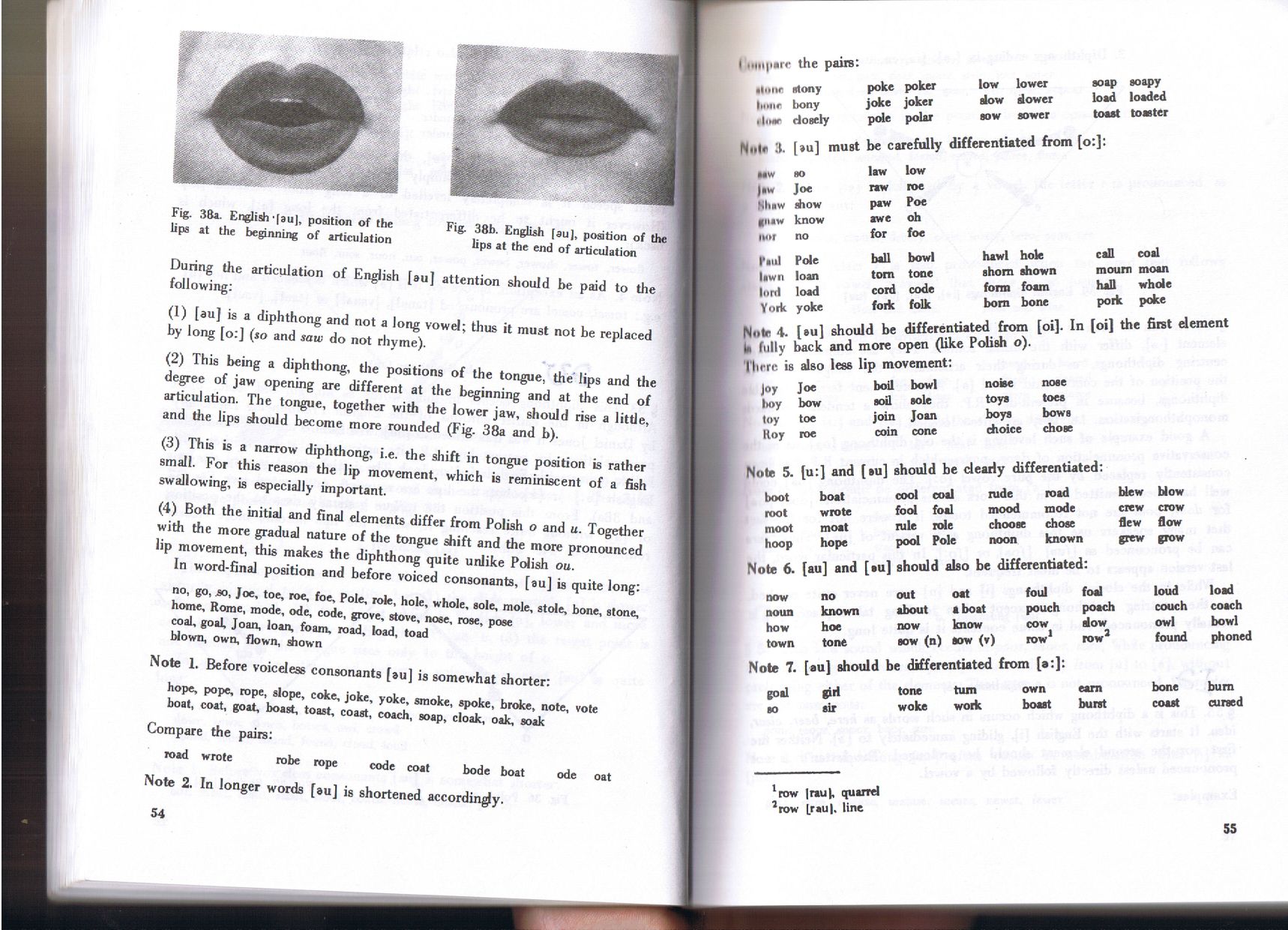CCF20100223�016

Fig. 38a. English'|au), position of tbe lipa at the beginning of articulation
Fig 38b. Knglish [ su ], position of the lips at the end of articulation
During the articulation of English [au] attention should be paid to the following:
(1) [au] is a diphthong and not a long vowel; thus it must not be replaced by long [o:] (to and saw do not rhyme).
(2) This being a diphtliong, the positions of the tongue, the lips and the degree of jaw opening are different at the beginning and at the end of articulation. The tongue, together with the lower jaw, should rise a iittle, and the lips should become morę rounded (Fig. 38a and b).
(3) This is a narrow diphthong, i.e. the shift in tongue position is rather smali. For this reason the lip movement, which is reminiscent of a fish swallowing, is especially important.
(4) Both the initial and finał elements differ from Polish o and u. Together with the morę gradual naturę of the tongue shift and the morę pronounced lip movement, this makes the diphthong quite unlike Polish ou.
In word-final position and before voiced consonants, [au] is quite long: no, go, so, Joe, toe, roe, foe, Pole, role, hole, whole, sole, mole, stole, bonę, stone, home, Romę, modę, ode, codę, grove, stove, nose, roae, pose coal. goal Joan, loan. foam. road, load. toad blown, own, flown, shown
Notę 1. Before yoiceless consonants [au] is somewhat shorter:
hope, pope, ropę, slope, coke, joke, yoke, smoke, spoke. broke, notę, vote boat, coat, goat, boast, toast, coast, coach, soap, cloak, oak, aoak
Compare the pairs:
road w rotę robę ropę codę coat bodę boat ode oat
Notę 2. In ionger worek [au] is shortened accordin^y.
r
I I *M1I[ «4n
|
1 ••'»i|i«rr the paire: | |||||||
|
Mmm |
Mony |
poke |
poker |
Iow |
lower |
aoap |
•ospy |
|
Imw* |
bony |
joke |
joker |
dow |
dower |
load |
loaded |
|
*ilMT |
doaeły |
pole |
polar |
aow |
aower |
toast |
toaater |
|
Nut* 3. |
[»u] must |
be carefully differentiated from |
to:]: | ||||
|
Mw |
ao |
law |
Iow | ||||
|
Joe |
raw |
n>e | |||||
|
Nh«w |
Aow |
paw |
fot | ||||
|
«"*w |
know |
awe |
oh | ||||
|
IWU |
no |
for |
foe | ||||
|
Psuł |
Pole |
bali |
bowl |
hawl |
hole |
cali |
coal |
|
lawn |
loan |
tom |
tonę |
ahom |
ahown |
moum moan | |
|
lord |
load |
cord |
codę |
form |
foam |
hall |
whole |
|
Yoik |
yoke |
foric |
folk |
bom |
bonę |
po* |
poke |
N«*r 4. [»u] should be differentiated from [oi]. In (oi] the firet element I* fully back and raore open (like Polish o).
Ilirrc ig algo less lip movement:
|
l°r |
Joe |
boil |
bowl |
noise |
noae |
|
boy |
bow |
aoil |
sole |
toya |
toea |
|
toy |
toe |
join |
Joan |
boya |
bow a |
|
Roy |
roe |
coin |
cone |
choiee |
chor |
|
Notę 5. [u |
:] and (au] should be dearly differentiated: | ||||
|
boot |
boat |
eool coal rude |
road blew |
biow | |
|
root |
wrote |
fool foal mood |
modę erew |
crow | |
|
moot |
moat |
nile role chooai |
: chose flew |
Sow | |
|
hoop |
hope |
pool Pole noon |
known grew |
RTOW | |
|
Notę 6. [a |
u] and [i |
iu] should also be differentiated: | |||
|
now |
no |
out oat |
foul foal |
loud |
load |
|
noun |
known |
about a boat |
pouch poach |
couch |
coach |
|
ho w |
hoe |
now know |
co w dow |
owi |
bowl |
|
town |
tonę |
sow (n) sow (») |
row1 row5 |
found |
phoned |
|
Notę 7. 1 |
au] should be differentiated from (•:]: | ||||
|
goal |
gid |
tonę tum |
own eam |
bonę |
bum |
|
sir |
woke work |
boaat bunt |
coast |
cuned | |
Wyszukiwarka
Podobne podstrony:
CCF20100223�016 Fig. 38a. English
CCF20100223�008 3y6: ■ Lnng central e, Le. (a:] Fig. 28. Poation of the lips Fig. 27. English (»:),
CCF20100223�007 Fig. 25. English
CCF20100223�005 Fig. 21. Englńti [u:), lougue poation Fig. 2Z Position of the lips
CCF20100109�002 TOPIĆ SENTHNCES - advanced Topie scntenccs can bc positioned at the beginning, in th
CCF20100216�004 12 English Phonetics and Phonology ii) In making the two vowels described above, it
18 Promottng community coheńon in Englisb education settings on tbe esample of Bamfield South Academ
Six diphthongs of American English (/au. ai, el, ou, di, ju/) were produced by four midwestcrn Ameri
essent?rving?02 Fig 9.13 Top view of tbe can at an early stage. Fig 9.11 Preparatory drawing of a sq
GH2 Fig. 4 Litbostrarignpfeic subć:vi$icn of tbe Disancun in the Morayio-SUesicn zora Doln karbon. s
CCF20100216�004 12 English Phonetics and Phonology ii) In making the two vowels described above, it
Fig. 5. Calculated heat losses (q2.q3.qi, qs) vs. stcam power for three levels of sloichiometric rat
P1130005 Fig. 1.24: Intense echogenicily (arrows) at the site of the est-rous follicle one day after
więcej podobnych podstron